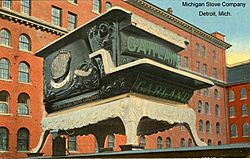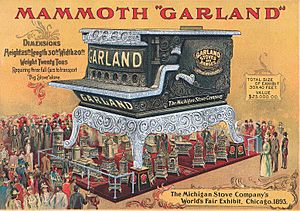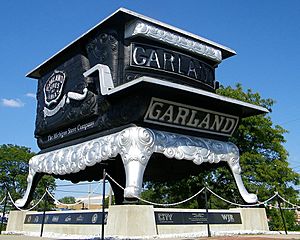World's Largest Stove facts for kids
Quick facts for kids World's Largest Stove |
|
|---|---|

The Michigan Stove / Mammoth Garland
|
|
| Artist | William J. Keep |
| Year | built 1893 / restored 1998 destroyed 2011 |
| Type | Sculpture |
| Medium | wood 25 ft high x 20 ft wide x 30 ft long |
| Location | Detroit, Michigan |
The World's Largest Stove was a huge model of a kitchen stove. It was also known as The Michigan Stove or Mammoth Garland. This giant stove was built for the 1893 Chicago World's Fair. Its purpose was to show off the Michigan Stove Company and its products.
After the fair, the stove was moved to Detroit. It stayed there for many years, helping to advertise the company. Over time, the wooden stove began to fall apart. In 1974, its pieces were put into storage. Later, in the late 1990s, the stove was fixed up. It found a new home at the Michigan State Fairgrounds. Sadly, in 2011, the World's Largest Stove was destroyed by a fire. People think lightning caused the fire.
Contents
How the Giant Stove Was Made
The World's Largest Stove was a giant copy of a popular cooking stove. The Michigan Stove Company wanted to get a lot of attention. They hoped to impress visitors at the 1893 Chicago World's Fair. So, they decided to build this huge stove model.
Jeremiah Dwyer started the company in 1872. George Harrison Barbour, a company leader, suggested the giant stove idea. William J. Keep, the company's superintendent, designed it. He also watched over its building and moving. The stove was made from oak wood and had a steel frame. It stood 25 feet (7.6 m) tall. It was 20 feet (6.1 m) wide and 30 feet (9.1 m) long. It weighed 15 short tons (14,000 kg).
The stove was decorated with hand-carved wood. This included basswood, Michigan white pine, and redwood. Its sides were painted to look like metal. This made it seem like a real Garland brand stove. The huge model was sent to Chicago on three train cars. It was set up in the Manufacturers Building at the fair. This building was very tall, about 200-foot (61 m) high. The giant stove looked like it was walking. It was the main part of the company's display. Smaller, real stoves were placed underneath it. Salespeople were nearby to talk about the stoves.
The Stove Comes Home to Michigan
After the World's Fair, the giant stove returned to Detroit. It was placed on a stand outside the Michigan Stove Company factory. This was on East Jefferson Avenue. On July 31, 1902, a special bronze plaque was put up. It marked a historical spot near where the stove stood. This spot was important because of a battle that happened there long ago.
The factory had a small fire in 1907. But the giant stove was not harmed. In 1927, the stove moved again. It went to the new Detroit-Michigan Stove Company plant. This plant was near the Belle Isle Bridge in Detroit. It was put on a new base for everyone to see. At this time, the stove's sides were repainted. They now said "Detroit-Michigan Stove Co." From 1957 to 1965, a bakery called Schaefer Bakeries used the stove. They rented it to advertise their bread. They painted "Schaefer Bread" on its sides.
A New Home at the State Fairgrounds
In 1965, the stove moved to the Michigan State Fairgrounds. This was on Woodward Avenue in Detroit. Over time, the weather damaged the stove. It started to break into pieces. By 1974, it looked very bad. Its paint was peeling, and the roof was sagging. The fence around it was broken. There was trash and old campfires nearby.
Later that year, the pieces were stored in a warehouse. This warehouse belonged to the Detroit Historical Museum. The museum then started a group to save the stove. They asked for help and money to fix it.
In the early 1990s, people became interested in fixing the stove again. They said it was a Detroit landmark. It showed how important Detroit was for metalwork and foundries in the past. Detroit was even called the "stove capital of the world." A project to restore the stove began. John C. Hertel, a former state fair manager, led the effort. Companies, unions, and people gave $300,000.
In 1995, twenty truckloads of stove pieces went to the Fairgrounds. Skilled workers from Greenfield Village started the repair work. They removed twelve layers of old paint. They also replaced 40% of the wood that was too damaged. During the repairs, a rubber layer was added to the top. This would help protect it from rain and snow.
Michigan's governor, John Engler, showed off the finished stove on August 24, 1998. The names of the main helpers were put on a concrete wall around the stove's legs. Walkways leading to the stove were made of special bricks. These bricks had the names of people who gave $25 to help with the repairs. The stove became a big attraction at the yearly state fair. It was advertised far away in places like Chicago and Indianapolis.
By 2009, the Michigan state fair was stopped due to money problems. People then looked for a new home for the giant stove. Ideas included the Henry Ford museum and a lodge in Lewiston, Michigan.
The End of the Giant Stove
A new home was never found for the World's Largest Stove. It stayed at the Michigan State Fairgrounds. Sadly, on August 13, 2011, it was destroyed by fire. A fire chief in Detroit said the fire was natural. They believed a lightning strike was the likely cause. Firefighters arrived around 8:00 pm. But the wooden stove had already burned down to its steel frame. It could not be saved. The State of Michigan planned to return the special memorial bricks to the people who bought them.
Images for kids





